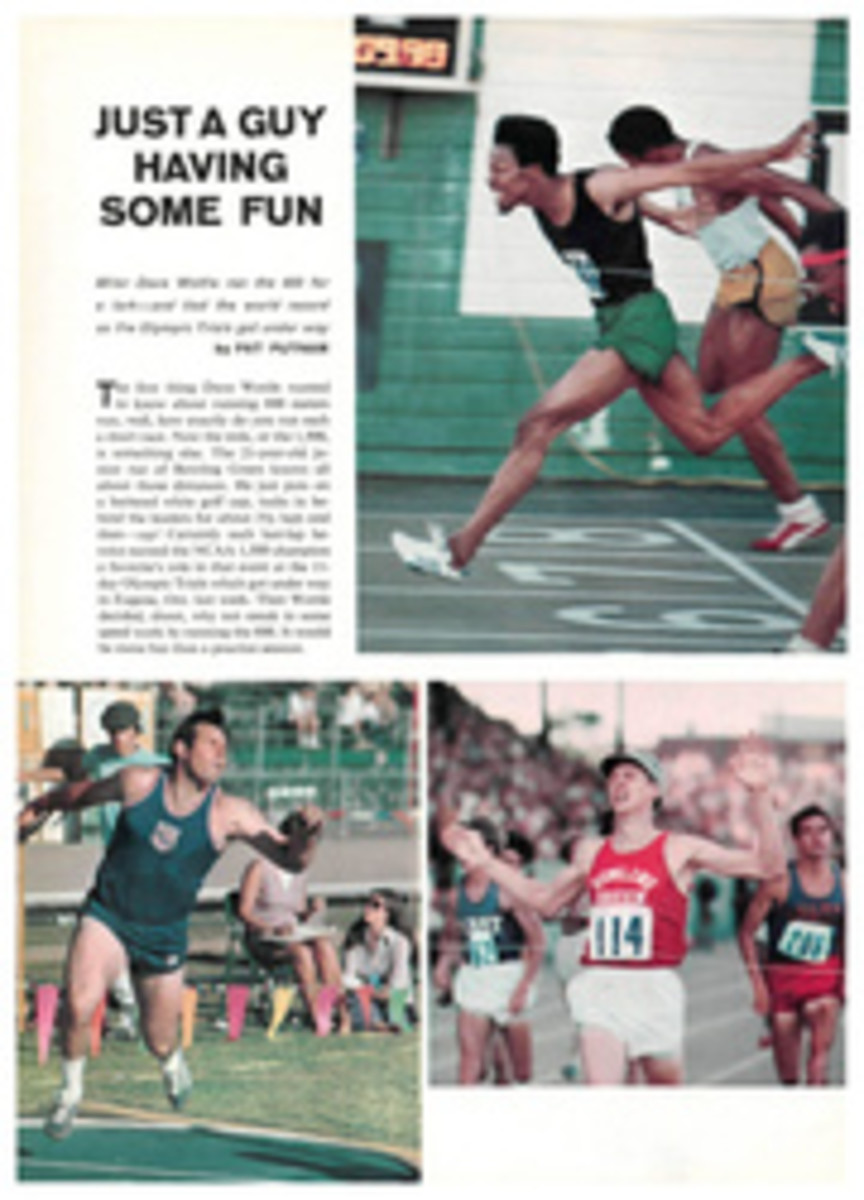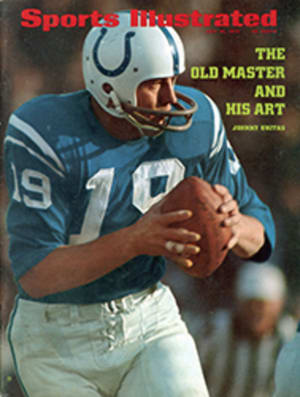
Try your hand at beating the Blues
Two weeks ago in the World Team Olympiad (SI, July 3) the vaunted Italian Blue Team trounced the Dallas-based Aces in matchless fashion. Matchless, but not quite flawless, as this deal, which may offer comfort to the less expert player, will attest. To appreciate declarer's problem, cover the East-West cards in the diagram.
The play of the four-heart contract required more than 10 minutes and many of the 500 spectators watching Pietro Forquet (the declarer) and Benito Garozzo for the Blues and Aces Bob Hamman and Paul Soloway via closed-circuit television and Vu-Graph wondered what was taking Forquet so long. Initially, of course, there was the question of what to do on the first trick. Forquet carefully counted the teeth of what he suspected might be a Trojan horse but finally decided to duck the spade 10 in dummy. East played low and the queen won. If you still have your thumbs over the East-West cards, how would you plan your play to make four hearts? I'll give you a hint: the next move is crucial, and the fact that the wrong choice might succeed brings you no accolades.
Because they could see all 52 cards on the Vu-Graph screen, the nonexperts in the audience could find the way to make the game with little difficulty. Mentally, they crossed to the ace of spades, led the queen of hearts for a successful finesse and continued trumps, picking up East's king. Next would come the ace and jack of diamonds, and if West was unwary enough to duck, they would lead a third round of diamonds to force out the king. Then with dummy's ace of clubs as an entry to the good diamonds, they would make six! Even if West did not duck the diamond jack but won and knocked out dummy's ace of clubs, they would still lose only two clubs and a diamond trick to bring home the game.
The glorious success of this line of play was duly noted by the commentators. They did not fail to point out, however, that Olympians of bridge envision subtle hazards in hands like this and therefore often have far more trouble than mere mortals. The fear that haunted Forquet was: What would happen if he crossed to dummy with the spade ace, finessed the heart queen and won that trick, then repeated the finesse and West now produced the king of hearts and shifted to a club, knocking out dummy's side entry to the diamonds?
Forquet's eventual decision was to cash the ace of hearts and lead low to dummy's queen. Soloway, whose card play for the Aces was brilliant throughout, thereupon won the king of hearts and returned the king of clubs, which, after another long trance, Forquet allowed him to hold. Soloway then conducted his own protracted self-conference, during which the commentators erroneously decided that a club continuation was essential. Actually, a spade would have done as well, but Soloway did come up with a club return and the contract was doomed.
Forquet won with dummy's ace and had no better choice than to finesse in diamonds. Hamman took his king and it did not matter whether he returned a diamond or a club. As it happened, he gave his partner a diamond ruff at once, but even if he had returned a club, Forquet would have had to ruff in dummy and lead a diamond himself, giving East his ruff anyway.
Did you make the correct play that Forquet missed at trick two? Leading a low heart first—not the ace—works against all defenses. Even if Soloway ducks, declarer makes his game without taking the heart finesse by cashing the club ace, conceding a club and ruffing his third club in dummy. Regardless of what the defenders choose to do at any stage, declarer can find a counter that will insure against the loss of more than three tricks.
Is it hard to believe that superior players can fail? Well, Bobby Goldman, the declarer for the Aces in the Closed Room, found a different way to go down at the same contract. After a club lead, he took the heart finesse and refused to believe his good fortune. In the ensuing tangle he, too, succumbed to a diamond ruff. Much excitement; but no point swing.
In the main, my pre-Olympiad predictions (SI, June 5 and 12) held up well, but my crystal ball appears to have been clouded over in two spots. One concealed the unexpected strength of the French. Their fourth-place finish seemed the result of hot-potato handling; yet when the Nationalist Chinese, still in contention going into the final qualifying round, ended in a "you take it, we don't want it" manner, the French were in a position to accept. Chalk it up to the steadiness of an experienced anchor pair, Claude Delmouly and Gerrard Bourchtoff, and to the brilliance of young Michel Lebel, whom some consider to be the best young French player today.
The second and major flaw in my crystal was revealed when the Italian signoras proved that they, too, share the mastery of bridge Italian style. Tournament Director Harold Franklin rates Anna Valenti as the leading woman bridge player in Europe, if not the world, and she and her co-stars, all present European women's champions, had no difficulty in taking the women's Olympiad title. All hopes for my home team selection, the U.S. women, vanished when they bowed to Italy 16 victory points to four in a match that drove our girls deep into third place. They finished there, behind South Africa. Why? It may have been the result of an overconfidence that made it seem unnecessary for our women to practice as a team.
For the rest, the Olympiad was largely a social affair. Brazil, winner of the South American championship, had the satisfaction of finishing ahead of all other Latin American entries. And for two others, there was the struggle to avoid the wooden spoon—a dingdong battle of midgets involving the Netherlands Antilles and the Bahamas, who met in the penultimate round tied for last place. The Dutch colonials had scouted their rivals during the previous round, sending observers to make notes as Peru blitzed the Bahamas. The research paid off. They beat the Bahamas 18-2 to escape the ignominy of finishing at the bottom of the heap.
Could the Aces ever beat the Blue Team? In Miami Beach, the Blues, especially when they used Giorgio Belladonna-Walter Avarelli and Pietro Forquet-Benito Garozzo (Mimmo d'Alelio and Camillo Pabis Ticci sat out all but 16 of the final 88 deals), rarely gave the Aces an opening. Their bidding judgment—even in the spots Garozzo picked to overbid—was superb. And their opening leads repeatedly torpedoed enemy contracts. But in most other respects, the Aces were their equal. The newest and youngest Ace, Paul Soloway, appears to have settled into a fine partnership with Robert Hamman. Bobby Wolff and Jim Jacoby, though they had some early slam disasters, are sound mainstays for the team. Bobby Goldman and Mike Lawrence produced a brilliant performance in the only session that saw the Aces outscore the Blues. Then, when it looked like the tide might be turning, the Blues regained command. In a game that is falling more and more into younger hands, the invincible Italians were much too strong for a team they were spotting some 16 years.
Unfortunately, the Aces may never get a chance to prove themselves. The Blues seem to really mean it when they say they have made their last appearance as a team. No doubt one or two of the old Blues will appear against the defending champion Aces in the 1973 Bermuda Bowl, which Italy earned the right to vie for by winning the European championship in Athens last year. The team at Athens included Belladonna and Garozzo, who have continued to play on their own. Together, I would rate them the greatest pair in the world today. But even if they do not play as partners in 1973, any team that can field two such awesome performers—and this is the big psychological edge Italy holds against every opponent—must be seriously regarded. The Blue Team may be retired, but the mystique is going to live on and on.
ILLUSTRATION
East-West vulnerable South dealer
NORTH
[Ace of Spades]
[9 of Spades]
[Queen of Hearts]
[10 of Hearts]
[4 of Hearts]
[Ace of Clubs]
[9 of Clubs]
[10 of Diamonds]
[9 of Diamonds]
[8 of Diamonds]
[7 of Diamonds]
[5 of Diamonds]
[2 of Diamonds]
WEST
[King of Spades]
[Jack of Spades]
[10 of Spades]
[7 of Spades]
[5 of Spades]
[6 of Hearts]
[5 of Hearts]
[Jack of Clubs]
[4 of Clubs]
[3 of Clubs]
[King of Diamonds]
[6 of Diamonds]
[4 of Diamonds]
SOUTH
[Queen of Spades]
[2 of Spades]
[Ace of Hearts]
[Jack of Hearts]
[9 of Hearts]
[8 of Hearts]
[2 of Hearts]
[7 of Clubs]
[6 of Clubs]
[2 of Clubs]
[Ace of Diamonds]
[Queen of Diamonds]
[Jack of Diamonds]
EAST
[8 of Spades]
[6 of Spades]
[4 of Spades]
[3 of Spades]
[King of Hearts]
[7 of Hearts]
[3 of Hearts]
[King of Clubs]
[Queen of Clubs]
[10 of Clubs]
[8 of Clubs]
[5 of Clubs]
[3 of Diamonds]
SOUTH
(Forquet)
1 [Heart]
2 [Heart]
PASS
WEST
(Hamman)
PASS
PASS
PASS
NORTH
(Garozzo)
2 [Diamond]
4 [Heart]
EAST
(Soloway)
PASS
PASS
Opening lead: 10 of spades

